
SITI Company production in progress: Ellen Lauren as the Persian Queen against a backdrop of golden drapery. At right, J.Ed. Araiza, actor in the Persians Chorus. Photo: Ellen Mezzera
An opulent drama told through the voices of Persian courtiers, Aeschylus’s Persians combines visual spectacle with powerful, lyrical storytelling.
The play is a challenge to translate and interpret because of its alien grandeur and despair—almost half the play was sung or chanted while the chorus danced, but the Greek poetry and song are almost impossible to render into English. The desperate funereal lament at the end of the play has no modern parallels. Yet it is well worth the effort to try to understand this play and see it through ancient eyes as well as our own.
Here, a guide to the essential elements of Persians, from its historical background to the message it sends to those who read or see it today.
The Plot
Elderly advisors to the Persian court serve as the play’s chorus. Their king, Xerxes, has left to invade Greece with a mighty army, but has not returned. The chorus’s fears mount; the men worry alongside Xerxes’s frightened mother, learn terrible news from a messenger, and invoke Xerxes’s father, the great deceased King Darius, to rise from his tomb onstage. The advisors eventually meet the disgraced and defeated Xerxes upon his return, and together they mourn the devastation of Persia.
More accurately, while the Persians lost decisively in this invasion (after, however, burning Athens), they did not lose their empire, as Aeschylus suggests. In fact, they remained a powerful force for generations.
The Play
Persians is the earliest Greek play to survive, and also the only extant play based on historical events. Its focus is the Battle of Salamis, won by the Greeks against an overwhelming Persian naval force in 480 B.C., eight years before the production in 472 B.C.
Aeschylus glorifies the victors, but also universalizes the horrors and lessons of one specific war. Persians was originally presented alongside three mythological plays—each standing alone, or all perhaps linked thematically to a military threat. The Athenian playwright fought the Persians under Darius at Marathon in 490, and he probably took part at Salamis as well. Writing as a soldier and veteran of wars with Persia, Aeschylus was biased toward the Athenians, and intentionally represents the enemy as arrogant, luxury-loving, and overly emotional. However, he also allows us to sympathize with Xerxes’s family and royal court.
Persians was chosen many times over many centuries, by unknown but key decision-makers, to represent Aeschylus’s work. The play was copied and recopied, first as a scroll and then a book. It was one of just seven of his plays selected from an original total of perhaps 70 to 90. The earliest complete manuscript of Persians dates to around A.D. 1000. Known simply as “M” today, this manuscript was collected by Lorenzo de’ Medici in the fifteenth century. Some 100 years later, the first printed copies circulated in Europe.
The Playwright

Marble bust of Aeschylus (Rome, Museo Capitolino) reproduced in Aeschylos. Tragedies and Fragments (London, 1901). The Getty Research Institute, 86-B18055
When Persians won first place in 472 B.C. at the City Dionysia, the annual Athenian festival honoring the god Dionysos with singing and theatrical performances, Aeschylus was probably in his early 50s, a conservative master of plays incorporating complex poetry, song, and dance. According to Aristotle, he was also an innovator who introduced the second actor to tragic performance. Before this, a single figure interacted with the chorus, and before that, in the late sixth century, the chorus performed alone.
Aeschylus was known for his grand ideas, complex poetry, fabulous costumes, dramatic choreography, and beautiful lyrics. He invented his own adjectives, which could make his plays hard to follow. While he was much admired, other artists—and presumably the general population—sometimes poked fun at his dense language and serious themes.
In the comedy Frogs (produced in 405 B.C.), Aristophanes pits Aeschylus against Euripides in an underworld competition for the title of best playwright. Aeschylus had died fifty years earlier, and Euripides one year before the first production of Frogs. Euripides and Dionysos, the judge of the contest, both reference Aeschylus’s solemn incomprehensibility. Aeschylus himself proudly describes how he improved the theater with his martial heroes, declaring that in Persians he “taught men to be eager to conquer their rivals.” Dionysos admires Persians, too, but in order to make fun, Aristophanes reduces the play to dramatic cries and sorrowful clapping (see lines 1026 and following).
The Modern Challenge

SITI Company’s production-in-progress for Aeschylus’s Persians at the Getty Villa. Photo: Sara Radamacher
Any modern producer of Persians—including SITI Company—faces multiple artistic challenges.
Poetry. In ancient Greek, Persians is a rich poem. It is full of complicated lyrical singing meters, plus three meters for speech, and a chanting meter. As originally performed, the play was only half spoken; in particular, a long speech by the messenger who recounts the loss of the Persian navy is a tour de force. The other half of the play is taken up with formal, archaic singing and dancing. Contemporary artists must translate these into a modern performance, and re-imagining the original format is a very difficult enterprise, rarely confronted head-on.
SITI Company has focused especially on the chorus’s ancient rhythms of chant and dance, and the company incorporates music, Greek passages recited in meter, movements based on the beat of the meter, and gestures that remind us of the chorus as a synchronized entity.
Grief. Persians is deeply sad. Aeschylus starts the play with the worried courtiers, and sends the story downhill from there, culminating in what amounts to the destruction of Persian civilization. The play ends with an intense funereal dirge enacted by the chorus and Xerxes, who tear their hair and clothes and fill the theater with cries of sorrow, extreme in their time, and difficult to understand today (consider that we have no accepted exclamations of grief, aside from such old-fashioned expressions as Woe! or Alas!). But as Aeschylus displayed the Persians’ deep emotions to his ancient audience, they would have remembered their own wartime reactions of hope, fear, and desperation. SITI Company uses the chorus as a communal body from which individuals step forth to comment, advise uselessly, worry, and grieve.
War. Recent translations and performances of Persians have often made explicit parallels between contemporary wars and the Persian Wars. Choosing whether or not to draw these parallels—which make the events more relatable but also introduce a note of political commentary—is an important artistic choice. When SITI Company read Persians in Aaron Poochigian’s 2011 translation to a Getty Villa audience in spring 2014, the experience and the audience response convinced the company to present the play using his direct, but poetic, translation.
At certain moments in the play Aeschylus must have meant the Athenian crowd to be filled with pride. At other times he may have meant Athenians to question their own behavior in political matters and as leaders of their own small empire, a group of city-states who joined together after Salamis for self-protection. The play has many layers, and we should not imagine that we see them all or that everyone in the audience, which included visitors from outside Athens, would have reacted to the performance in the same way.
The Message
Persians celebrates the Athenians and their victory and represents the Persian King Xerxes as an arrogant and rash youth who ruins his people. However, Aeschylus also personalizes the true devastation of war visited upon one family: the anguish of a mother and queen, the horror of a father and king crushed by the folly of his son, and the humiliation and pain of the Persian court. The deep sorrow of the chorus is palpable as the old courtiers first fear and then confirm that all is lost.
To play-goers in fifth-century B.C. Athens, the Persians’ lamentation was an extreme but recognizable expression of profound communal sorrow. The audience, too, was affected by the dreadful outcome of Salamis—the Athenians by their own losses, the visitors by their recollections of warfare. Despite the historical license Aeschylus took with Persian culture and politics, he effectively shows a stricken enemy’s point of view, and thereby permits viewers, and even the victors, to share in collective grief. His is a warning about the wages of war that bridges time, culture, and place.
_______
Further Reading
Persian History and Archaeology
The World of Achaemenid Persia: History, Art, and Society in Iran and the Ancient Near East, John Curtis and St. John Simpson. London: I. B. Tauris, 2010. Chapter 3 (pp. 21–31) treats the history of western scholarship on Persia and the quest to treat Persian history in its own right.
Aeschylus and the Play
Persians, Seven against Thebes, and Suppliants, Aeschylus in translation by Aaron Poochigian. Baltimore: Johns Hopkins, 2011.
Online English text of Persians with available Greek translation
Aeschylus: Persae, A.F. Garvie. Oxford: Oxford University Press, 2009.
Ancient Sources on Aeschylus
Aeschylus: A Guide to Selected Sources
Online English text of Aristophanes’ Frogs with available Greek translation
Aeschylus the Playwright
Aeschylean Tragedy, Alan H. Sommerstein. London: Bloomsbury Academic, 2010.
Greek (and Roman) Attitudes toward Persians
The Invention of Racism in Classical Antiquity, Benjamin Isaac. New Jersey: Princeton University Press, 2006. Chapters 4 and 8 discuss Greeks and the East and Parthia/Persia.
Greeks and Barbarians, Kistas Valssopoulos. Cambridge: Cambridge University Press, 2013. Pages 53–64 cover the Persian Wars and their aftermath.
Persian Kings in the Play
“A Tale of Two Kings: Competing Aspects of Power in Aeschylus’ Persians,” Rebecca Kennedy, in Ramus 42 (2013): 64–88. Rebecca Kennedy will speak at the Getty Villa about the play at 2:00 p.m. on Saturday, September 13, 2014.
Approaches to Performing Persians
Greek Tragedy on the American Stage: Ancient Drama in the Commercial Theater 1882–1994, Karelisa Hartigan. London: Greenwood, 1995. See especially pp. 102–104.
Reimagining Greek Tragedy on the American Stage, Helene Foley. Los Angeles: University of California Press, 2012. See pp. 154–159 and Appendix C.




This in-depth presentation of the PERSIANS caused me delight and left me highly curious. Your early announcement of the play made me purchase 2 tickets for the preview. However, I found no takers for a second ticket I had bought for interested friends. I sensed hesitation towards this serious and daring approach to a near-authentic handling of the language and the formal elements.
I will be delighted to attend by myself.
Most appreciatively,
Barbara Gross
Barbara, as the production has sold out for the preview dates, I shall not be seeing you. I will be going on a later date. It is indeed a delight to see this production and I am sure you will find many who share this joy. Have a great time!
Bren
Ike, his wife Alex, Barry and I see the Persians tonight. I was just doing some reviewing before our departure for L.A. and saw your comment. Hope you and your family are well. Fond best wishes, Jan
Really great to have that introduction to The Persians. ..otherwise I know it might well be
full of mysterious plot turns, heroes, heroines, wicked characters ….
Good to be able to watch it with some knowledge .
Thank you, Dr.Brown.